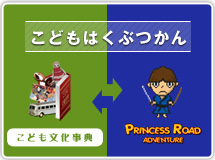Welcome to the Hyogo Prefectural Museum of History’s Online Museum
TOP > History Station Seminars
History Station Seminar content is designed to offer a systematic exploration of the diverse materials held by the Hyogo Prefectural Museum of History. Through these seminars, the deeper significance of the museum's materials will be carefully and entertainingly communicated in a way that simply in not possible with exhibits alone. It is our hope that families and schools alike will take advantage of this fun and educational content in order to bring to life the history and culture embodied in the museum’s collection.
-
This seminar provides a detailed introduction to the two editions of the Fukutomisoshi (The Tale of Fukutomi) picture scroll (earlier and later edition) created during the Muromachi period and currently held by the Hyogo Prefectural Museum of History.
Even if you are unable to read the antiquated cursive style of Chinese characters in the scroll, the story is presented in four stages - facsimile, reproduction, interpretation and modern translation - which can be viewed in the archives, along with a commentary and picture index, to make it possible for you to understand and appreciate the story on your own.
This will give you a deeper understanding of the otogi-zoshi (short stories) and picture scroll tradition which blossomed in medieval Japan and open you up to the excitement of making new discoveries for yourself. (Created in fiscal year 2016) - 日本語ENGLISH한국어简体中文
-
This seminar content lets you carefully inspect five items chosen from the arms and armor collection of the Hyogo Prefectural Museum of History. Although all of these arms and armor were originally created for battle, their historical significance comes also from the artistry and aesthetics they embody. Here you will be equipped with basic knowledge for, and key points to notice when, appreciating each piece of armor and sword.
It is also important to learn about and understand the cycle of conflict that drove the historical development of these arms and armor. (Created in fiscal year 2013) - Japanese text only
-
The Hyogo Prefectural Museum of History is home to the “Irie Collection”: a collection of around 110,000 “child culture” related materials that were amassed by the late Masahiko Irie during his lifetime and which now serve as the featured exhibition content of our Children’s Museum.
The toys of the Irie Collection have also been used to create two different types of History Station Seminar content; the first is the “Encyclopedia of Child Culture,” which makes use of an encyclopedia-style format to introduce the Irie Collection, and the second is the “Princess Road Adventure,” which takes the same content but presents it in an educational game format. This History Station Seminar content will hopefully provide an opportunity for reflection on how the distinctive features of different eras in history can be clearly seen even within children's toys. (Created in fiscal year 2012) - Japanese text only
-
The Hyogo Prefectural Museum of History has in its collection a painted folding screen depicting the Battles of Ikuta Forest and Ichi-no-Tani fought between the Taira and Minamoto clans. This work of art created in the early Edo period (17th century) portrays a number of episodes of battle that are described in the epic account of The Tale of Heike.
By deciphering the details of this folding screen, they will paint a clearer picture of the Battles of Ikuta Forest and Ichi-no-Tani, as well as of the time and place in which they occurred. (Created in fiscal year 2010) - Japanese text only
-
A great many of the ancient documents which remain to us from the Edo through Meiji periods are written in a cursive style of calligraphy which is practically indecipherable to non-experts.
For this History Station Seminar, an ancient document from the Hyogo Prefectural Museum of History collection which was produced by Oda Nobunaga, one of the most famous feudal lords in Japanese history, is introduced and examined from a variety of angles in order to not only find out what it says but how to go about deciphering the meaning of ancient documents of this sort. (Created in fiscal year 2010) - Japanese text only





